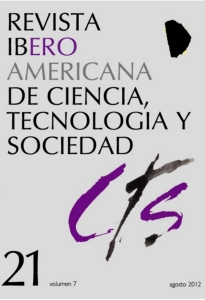Nuevas tecnologías: ¿para quiénes?
El caso de la nanotecnología
DOI:
https://doi.org/10.52712/issn.1850-0013-669Palabras clave:
tecnociencia, accesibilidad de la tecnología, exclusión social, principio de precaución, nanotecnologíaResumen
Este trabajo propone algunas reflexiones en torno a los alcances y consecuencias del creciente protagonismo de las actividades que genéricamente conocemos como “tecnociencia”, y que contribuyen en gran medida a consolidar un modelo de organización económica y social que segrega de sus beneficios a amplios sectores de la población y pone en riesgo la sustentabilidad del planeta. Los puntos que nos interesa examinar son: a) la difusión y accesibilidad de las tecnologías por distintos sectores sociales; b) las bases de legitimación que sostienen las posiciones de aceptación acrítica de los avances científico-técnicos; y c) el papel que debería cumplir el mundo institucional de las prácticas científicas y técnicas para que éstas sean puestas al servicio de una sociedad auténticamente democrática. Analizamos el caso de los desarrollos actuales en el campo de la nanotecnología a propósito de estos diferentes aspectos. Si bien existe hoy un gran consenso entre los especialistas en que la nanotecnología será un factor crucial para solucionar los graves problemas originados por la exclusión social que afecta a gran parte del planeta, a este mundo de promesas debemos ponerlo en correspondencia con otro, que genéricamente se refiere a la posibilidad de que esta nueva tecnología sea destinada a fines menos altruistas.
Descargas
Citas
CEZAR, F. G. y ABRANTES, P. C. (2003): “Princípio da precaução: considerações epistemológicas sobre o princípio e sua relação com o processo de análise de risco”, Cadernos de Ciência & Tecnologia,nº 20, pp. 225-262.
COMEST (World Commission on the Ethics of Science and Technology) (2005): The precautionary principle,París, UNESCO.
DELGADO RAMOS, G. C. (2004): “Promesas y peligros de la Nanotecnología”, Nómadas: revista crítica de ciencias sociales y jurídicas, Universidad Complutense de Madrid. Disponible en: www.ucm.es/info/nomadas/9/giandelgado.htm.
FEYNMAN, R. (1960): “There’s plenty of room at the bottom”, Engineering and Science,vol. 23, nº 5, febrero, pp. 22-36.
IFCS (Intergovernmental Forum for Chemical Safety) (2008): Final Report. Sixth Session of the Intergovernmental Forum on Chemical Safety, Dakar, Senegal. Disponible en: www.who.int/ifcs/documents/forums/forum6/f6_finalreport_en.doc.
IPEN (International Pops Elimination Network) (2010): Breves antecedentes sobre nanotecnología y nanomateriales.Disponible en: www.ipen.org/ipenweb/work/nano/ ipennano_%2520kingston_background_spanish.pdf.
KATZ, C. (2009): “Crisis global II: Las tendencias de la etapa”, La página de Claudio Katz, 2 de diciembre. Disponible en: lahaine.org/katz/index.php?p=183&c=1.
LADRIÈRE, J. (1978): El reto de la racionalidad,Salamanca, Sígueme/UNESCO.
NACIONES UNIDAS: Informe Anual del año 2008 de Naciones Unidas sobre los Objetivos del Milenio. Disponible en: www.un.org/spanish/millenniumgoals/pdf/MDG _Report_2008_SPANISH.pdf.
PROGRAMA DE LAS NACIONES UNIDAS PARA EL DESARROLLO (PNUD) (2005): Informe sobre Desarrollo Humano 2005.Disponible en hdr.undp.org/en/media/HDR05 _sp_complete.pdf.
STRATEGIC APPROACH TO INTERNATIONAL CHEMICALS MANAGEMENT (SAICM) (2009): Información básica sobre las nuevas cuestiones normativas en relación con la nanotecnología y los nanomateriales manufacturados,25 de marzo. Disponible en: www.saicm.org/documents/iccm/ICCM2/meeting%20documents/ ICCM2%20INF34%20nano%20background%20S.pdf.
TESTART, J. & GODIN, C. (2001): El racismo del gen, Buenos Aires, Fondo de Cultura Económica.
THE ROYAL SOCIETY AND THE ROYAL ACADEMY OF ENGINEERING (2004): Nanoscience and nanotechnologies. Disponible en: royalsociety.org/Nanoscience- and-nanotechnologies-opportunities-and-uncertainties-/.
UNESCO (1999): Declaración sobre la ciencia y el uso del saber científico,World Conference on Science, Budapest. Disponible en: unesdoc.unesco.org/images/0011/ 001163/116341So.pdf.
UNESCO (2000): Declaración del Milenio.Disponible en: www.un.org/spanish/milenio /ares552.pdf.
UNESCO (2007): Ética y política de la nanotecnología. Disponible en: unesdoc.unesco.org/images/0014/001459/145951s.pdf.
Descargas
Publicado
Cómo citar
Número
Sección
Licencia
Derechos de autor 2024 CC Attribution 4.0

Esta obra está bajo una licencia internacional Creative Commons Atribución 4.0.
Todos los números de CTS y sus artículos individuales están bajo una licencia CC-BY.
Desde 2007, CTS proporciona un acceso libre, abierto y gratuito a todos sus contenidos, incluidos el archivo completo de su edición cuatrimestral y los diferentes productos presentados en su plataforma electrónica. Esta decisión se sustenta en la creencia de que ofrecer un acceso libre a los materiales publicados ayuda a un mayor y mejor intercambio del conocimiento.
A su vez, para el caso de su edición cuatrimestral, la revista permite a los repositorios institucionales y temáticos, así como también a las web personales, el auto-archivo de los artículos en su versión post-print o versión editorial, inmediatamente después de la publicación de la versión definitiva de cada número y bajo la condición de que se incorpore al auto-archivo un enlace a la fuente original.











